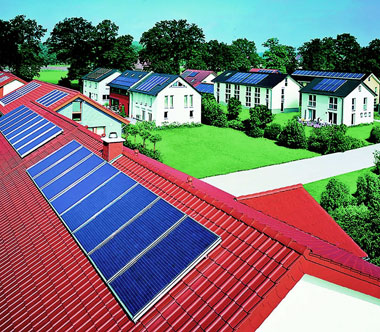|
 |
| A pilot rooftop solar-energy project is underway in the Hangzhou Energy and Environment Industrial Park. |
A major solar-energy project and on-grid power station in Hangzhou will go into operation at the end of this month. It will be the first photovoltaic (PV) plant in Zhejiang Province.
It includes a 2-megawatt rooftop project in the Hangzhou Energy and Environment Industrial Park.
PV technology converts sunlight directly into energy through solar panels.
Developing alternative energy sources, including solar power, is a high priority for China, and for Hangzhou.
The central government has said it is ready to finance PV stations and projects generating at least 500 megawatts in two or three years.
The current project in Hangzhou includes a Green Science and Technology Hall. Its 58-square-meter rooftop will be the first in China to incorporate building integrated photovoltaic (BIPV) technologies, according to Hangzhou media reports.
It will use high-efficiency tandem thin film PV modules with a light transmission rate of 30 percent, provided by Chint Solar Corp. The panels both let light into the hall and generate electricity.
"This is the first station in China using a combination of crystalline silicon based modules and high efficiency tandem thin film PV modules. It marks the official launch of the PV project in Zhejiang financed by the government," says Dr Yang Liyou, CEO of Chint Solar Corp.
The station aims to generate electricity of 2 million kilowatt hours annually, saving 800 tons of coal and reducing carbon dioxide emissions by 1,320 tons.
"This project is a symbol marking transformation of Zhejiang into a province with low-carbon economy," says Yang.
During the economic downturn, private investment has increased in alternative energy, aided by government support.
"We receive a lot of support from the government under this policy," says Wang Zhenjun, secretary to the president of Ningbo Solar Electric Power Corp.
The corporation has won two projects in Hangzhou. One uses BIPV in buildings of the provincial government, another applies PV for a Zhejiang sports training center with a swimming pool that draws a lot of electricity.
By May, Zhejiang Power Co has received applications from 28 companies for projects totaling 38,000-kilowatt PV projects.
The province has more than 60PV companies.
China, which is overwhelmingly dependant upon coal, is developing alternative energy sources to minimize greenhouse gas emissions and global warming.
In 2008, China's production of PV cells was 1,780 megawatts, but there were just 40-megawatt operating PV systems in the country, less than 1 percent of the PV systems globally.
The central government has drafted a New Energy Development Plan and building a low-carbon economy is part of overall economic development.
PV production in China is expected to reach 2,000 megawatts by 2020.
"The development of PV is a full expression of low-carbon economy," says Yang. |


